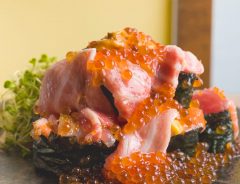
Source: Satoshi Hirayama
From fish genitalia to raw horse meat: 5 izakaya foods for adventurous eaters
Related Article
-

6000 Calorie, 50 cm Long Ehomaki Sushi Roll Will Invite More Setsubun Good Luck Than You Can Handle
-

Tokyo Nighttime Passport Wants To Be Your Portal To Tokyo Nightlife
-

“Otaku House” Promises Cheap Lodging and Fun Experiences For Otaku Tourists
-

Neon Genesis Evangelion Bar Opening Up In Tokyo Brings Second Impact Of Booze And Food
-

Overflowing otoro, uni and ikura sushi joins all-you-can-eat menu at Sushi Bar Fujiyama
-

Avoid crowds & enjoy an izakaya mood at home with British typographer’s Japan-limited posters


A lesson from Big Bird
A child of the nineties, my first exposure to Japan was the gutsy, gripping, epic, and eye-opening documentary, Big Bird in Japan. Even to a young child, the television special made clear that Japan is a magical place, although a little confusing at times. Thinking back now 30 years after it originally aired, my nostalgia is all the more poignant. Just this month, Caroll Spinney, the original Big Bird puppeteer, sadly passed away.
As a child, my main takeaway from the special was that Japanese food is very weird. If you recall, in the early scenes, Big Bird and his dog Barkley visit a restaurant. There, plastic dishes are displayed in the window, fish is served with head intact, and little sticks are used to eat. Also, what did Big Bird finally order? It was so slimy.
On the playground not long after, my friend Stevie confirmed what I until then believed to be impossible. "People in Japan eat raw fish," he whispered. "They don't even cook it, just cut it up and eat it." My jaw dropped. I thought I was going to be sick. You mean they don't deep-fry it? How is that even possible?
Fast-forward several years: I live in Japan and no longer the American Midwest, and I regret to inform you that the rumors are true. Sushi is raw fish. However, if you clicked on this article, you are probably well aware of that. You probably also know that is delicious.
Izakaya fare for adventurous eaters
If you're interested in following this squeamish rabbit-hole further, here are 5 more dishes that will make you quiver, or at least give you pause. But they will also make for a fun izakaya game of food chicken. We'll forego the obvious choices like blowfish or fish eggs. Also, we'll limit ourselves to dishes that are traditionally considered delectable. For wilder stuff like insect sushi, have a look over here.
Shiro-uo No Odorigui (Dancing Ice Fish)
Photo by Luke Mahoney
As far as fish is concerned, this is as raw as it comes. Shiro-uo no odorigui is a dish of ice goby that is eaten alive. They give a little tickle in your throat on the way down (odorigui literally means "dance eating" and refers to eating live seafood). With a consistency of dynamic jello, it's a texture, or sensation that takes some getting used to.
You'll need to fine-tune your chopstick skills beforehand. These little guys are sifted from a bamboo bowl into a hand bowl containing a vinegar or soy sauce broth. There, you'll need all your dexterity to snatch them in your waribashi as they squirm away. If you're successful, the salty and vinegar-esque taste is something you won't forget [1].
Basashi (Raw Horse Meat)
Photo by Luke Mahoney
If you grew up on a farm or otherwise have an equine friend, basashi may not be for you. No dish should be traumatizing. Nevertheless, raw horse meat is on the menu at many izakayas in Japan.
Similar to sashimi (raw fish), it is served with sides like aromatic shiso leaf, onions, wasabi, garlic, and so on. The unflavored meat, depending on the cut, is slightly sweet and chewy. Dip a bit in soy sauce or ponzu sauce to bring out a refreshing flavor [2].
While basashi is available in many places, for me, it's worth checking reviews if you're going somewhere specifically for the dish. The most famous places to indulge are in Kumamoto, Nagano, or Oita. There is also a grilled alternative available throughout the country.
And to all the horse-owners, please no angry letters. When in Rome, right?
Shirako (Cod Milt)
Photo by Luke Mahoney
Mmm, mmm, mmm. Nothing like fish semen to end the night. Yeah, I know what you're thinking. I like to put fish milt in my mouth.
"What are you, a gay fish?"
But Kanye would agree, it really isn't that bad. Just a little salty.
If you aren't aware, shirako, or milt, is the seminal fluid of fish or other sea creatures that procreate by spraying it onto roe, or unfertilized eggs. In Japan, it's also available to order at izakayas. For fear of being censored, I won’t describe the taste in detail. Suffice it to say, it's creamy.
Regardless, if you're out on the town with that special someone, it's said shirako has "rejuvenating" powers. So swallow your pride, and some milt, and enjoy a memorable night.
Namako sashimi
Photo by Luke Mahoney
Namako is sea cucumber, which, like a lot of seafood in Japan, can be consumed raw. The first impression is definitely that it's slimy. Yet, have a bite, and you'll find it's rather quite crunchy. The taste of sea cumber by itself is pretty bland; however, ponzu sauce livens things up nicely.
Namako is also the focus of several ASMR videos. Relaxing, I suppose, but enjoyable nonetheless. So, the next time you're hungry and can't sleep, there's also that.
Habushu (Okinawan Snake Wine)
Photo by Luke Mahoney
Finally, you're gonna need something strong to wash it all down. The Okinawans have you covered.
Awamori is a rice liquor that runs about 60 to 90 proof. While Japanese sake is brewed, awamori is distilled. It has a crisp flavor that is a little sweet and a bit alcoholic. It is often drunk on the rocks or mixed with water.
But throw in a venomous pit viper, and violà, you have habushu. To make the liqueur, a habu snake is put on ice until it passes out. It is then gutted and bled. When it comes to, it quickly strikes out and dies. Its final pose is with an ominous, gaping maw. As such, it is stored in ethanol before being placed in awamori. Like shirako, habushu has aphrodisiac properties [3]. Please enjoy responsibly.